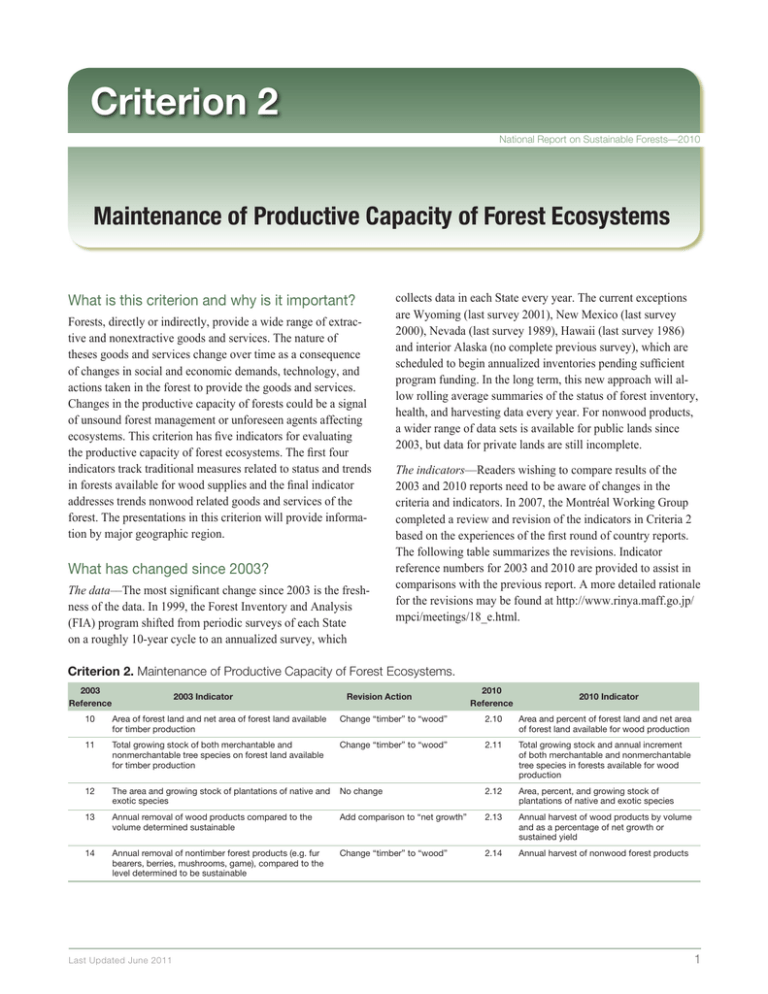Criterion 2 Maintenance of Productive Capacity of Forest Ecosystems
advertisement

Criterion 2 National Report on Sustainable Forests—2010 Maintenance of Productive Capacity of Forest Ecosystems What is this criterion and why is it important? Forests, directly or indirectly, provide a wide range of extractive and nonextractive goods and services. The nature of theses goods and services change over time as a consequence of changes in social and economic demands, technology, and actions taken in the forest to provide the goods and services. Changes in the productive capacity of forests could be a signal of unsound forest management or unforeseen agents affecting ecosystems. This criterion has five indicators for evaluating the productive capacity of forest ecosystems. The first four indicators track traditional measures related to status and trends in forests available for wood supplies and the final indicator addresses trends nonwood related goods and services of the forest. The presentations in this criterion will provide information by major geographic region. What has changed since 2003? The data––The most significant change since 2003 is the freshness of the data. In 1999, the Forest Inventory and Analysis (FIA) program shifted from periodic surveys of each State on a roughly 10-year cycle to an annualized survey, which collects data in each State every year. The current exceptions are Wyoming (last survey 2001), New Mexico (last survey 2000), Nevada (last survey 1989), Hawaii (last survey 1986) and interior Alaska (no complete previous survey), which are scheduled to begin annualized inventories pending sufficient program funding. In the long term, this new approach will allow rolling average summaries of the status of forest inventory, health, and harvesting data every year. For nonwood products, a wider range of data sets is available for public lands since 2003, but data for private lands are still incomplete. The indicators––Readers wishing to compare results of the 2003 and 2010 reports need to be aware of changes in the criteria and indicators. In 2007, the Montréal Working Group completed a review and revision of the indicators in Criteria 2 based on the experiences of the first round of country reports. The following table summarizes the revisions. Indicator reference numbers for 2003 and 2010 are provided to assist in comparisons with the previous report. A more detailed rationale for the revisions may be found at http://www.rinya.maff.go.jp/ mpci/meetings/18_e.html. Criterion 2. Maintenance of Productive Capacity of Forest Ecosystems. 2003 Reference 2003 Indicator Revision Action 2010 Reference 2010 Indicator 10 Area of forest land and net area of forest land available for timber production Change “timber” to “wood” 2.10 Area and percent of forest land and net area of forest land available for wood production 11 Total growing stock of both merchantable and nonmerchantable tree species on forest land available for timber production Change “timber” to “wood” 2.11 Total growing stock and annual increment of both merchantable and nonmerchantable tree species in forests available for wood production 12 The area and growing stock of plantations of native and exotic species No change 2.12 Area, percent, and growing stock of plantations of native and exotic species 13 Annual removal of wood products compared to the volume determined sustainable Add comparison to “net growth” 2.13 Annual harvest of wood products by volume and as a percentage of net growth or sustained yield 14 Annual removal of nontimber forest products (e.g. fur bearers, berries, mushrooms, game), compared to the level determined to be sustainable Change “timber” to “wood” 2.14 Annual harvest of nonwood forest products Last Updated June 2011 1

